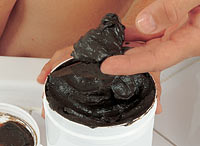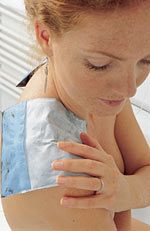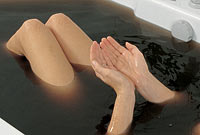What exactly is moor
In geology, a layer or sequence of layers of peat at least 30 cm thick is considered a bog (oder: moor). A distinction is made between upland moor and fens according to their deposit.
The fen peatlands, such as the Neydharting Moor, are formed by the accumulation of plant remains that do not decompose completely. This is because the organisms in the ground are inhibited in their vitality by the prevailing very wet conditions and the lack of air.
The healing moor of Neydharting
The healing moor of Neydharting ist situated in the middle of Austria, in the Alpine foreland of the world-famous Salzkammergut. In this beautiful, pre-alpine moraine landscape, small glacial lakes silted up over the course of several millennia and fens were formed.
The silting up was caused by intensive plant growth. The abundance of plant nutrients in the waters seeping in from the slopes of the valley was the reason for this lush vegetation. In addition to the lush vegetation, there was also the diversity of plant species specific to this area that The ever-growing biomass at the water table sank into the water repeatedly throughoutin its vegetation cycle and – after a biological transformation process of humification – created the basis for the formation of the organic mass with a great variety of moor ingredients (moor bouquet).
Today, the hollows of the glacial lakes are filled with healing moor. The Wimbach stream, which flows through the valley, indicates the water level of the hollows filled with healing moor today.
Not all moors are the same
 From the beginning of classical mud therapy about 200 years ago until the middle of the last century, focus lied on the positive thermophysical healing effects of the thick bubble baths and mud packs, regardless of the individual origin as upland moor or fen. The reason for this is that the thermophysical properties of moor are easy to study and every type of moor that meets the requirements of the “Heilvorkommen- und Kurortegesetz” (law on healing and health resorts in Austria) has comparable thermophysical properties.
From the beginning of classical mud therapy about 200 years ago until the middle of the last century, focus lied on the positive thermophysical healing effects of the thick bubble baths and mud packs, regardless of the individual origin as upland moor or fen. The reason for this is that the thermophysical properties of moor are easy to study and every type of moor that meets the requirements of the “Heilvorkommen- und Kurortegesetz” (law on healing and health resorts in Austria) has comparable thermophysical properties.
 The thermophysical effect of e.g. mud packs is based in particular on the particularly high heat retention capacity and the poor thermal conductivity. On the one hand, both properties allow high temperatures at the beginning of the application, but on the other hand they allow a long-lasting temperature constancy of the medium. Thus, a gentle overheating of the body and a better blood circulation of the body parts covered by the mud can be achieved.
The thermophysical effect of e.g. mud packs is based in particular on the particularly high heat retention capacity and the poor thermal conductivity. On the one hand, both properties allow high temperatures at the beginning of the application, but on the other hand they allow a long-lasting temperature constancy of the medium. Thus, a gentle overheating of the body and a better blood circulation of the body parts covered by the mud can be achieved.
 When using so-called suspended matter baths, thermophysical effects recede into the background. Pharmacological effects come into play. They are based on the ability of water-soluble moor components (moor extract, moor bouquet) regarding the penetratation of human skin.
As scientific studies showed in the 1990s, there are striking differences between the individual healing moor deposits. These new research results lead to the conclusion that the pharmacological effect depends on the composition of the plant material and the geological framework conditions under which the moor was formed.
When using so-called suspended matter baths, thermophysical effects recede into the background. Pharmacological effects come into play. They are based on the ability of water-soluble moor components (moor extract, moor bouquet) regarding the penetratation of human skin.
As scientific studies showed in the 1990s, there are striking differences between the individual healing moor deposits. These new research results lead to the conclusion that the pharmacological effect depends on the composition of the plant material and the geological framework conditions under which the moor was formed. | Parameters | Upland Moor | Fens (e.g. Neydharting) |
| Development/Formation | From low-variation plant communities, formed above water level | From varied plant communities, formed at water level |
| Unwanted components/admixtures | Woolgrass fibres | Roots and wood debris, sand, Clay |
Peat ingredients | Few in higher concentrations | Many in lower concentrations (moor bouquet) |
| Degree of humification | H6 – 8 | H8 – 10 |
| pH-Value | 3,0 – 5,0 (strongly acidic) | 4,0 – 7,5 (weakly acidic) |
| Nitrogen | 1,2 % organic dry matter | 3,3 % organic dry matter |
| Sulphur | 0,25 % organic dry matter | 0,5 – 5% organic dry matter |
| Humic acids | 24,9 % organic dry matter | 34,0 % organic dry matter |
| Humic substances | 30,5 % organic dry matter | 36,3 % organic dry matter |
| Minerals and essential micronutrients | 1 – 2 % der dry matter | 5 – 15 % der dry matter |
| Water content (normal consistency) | 92 – 96 % | 83 –93 % |
The healing moor of Neydharting is a fen
History and myths about the Neydharting healing moor
The moor in Neydharting is one of the best-studied natural healing resources in the world.
Did you know…
… that Roman villas were not only built in Rome?
An excavation of a Roman villa (built around 250 AD) shows that even the Roman Empire appreciated the Neydharting area; was it the moor that made them stay?
… that a sinister robber baron was up to mischief in the “Veste”?
After the Magyar invasions around 900, the Veste Neydharting – a moated castle – became the base camp, so to speak. Allegedly, it was inhabited by robber barons.
The first documentary evidence of the existence of Neydharting is the deed of sale of the lord of the castle “Chunrad de Nytterdinge” around 1100.
… that monks were the first to step into (oder: to bathe in) the healing brown water?
The healing effects of the Neydharting Moor became known in the Middle Ages. There is a “moswisen, moorbach … von einer wisn bey dem prunn und der padstuben …” wrote Abbot Thomas von Lambach in 1364. This is the first written proof of the existence of a bath in Neydharting.
The discovery of a medieval bathtub is considered to be the oldest find of a moor bathing facility ever (see illustration).
… that Paracelsus undertook a strenuous journey to Neydharting to personally verify the effects of the moor?
The natural scientist, physician and theologian Theophrastus, Bombastus von Hohenheim, called PARACELSUS, was in Neydharting and reported around 1500 that he found the “Quinta Essentia” in a “gemös” of the “Veste Neydhärding”.
… that Neydharting was a wellness meeting place in the early modern era?
It is said that around 1600 many elder, sickly and frail people made a pilgrimage to the “fountain of youth” in Neydharting and gained “miraculous power”. The astronomer Johannes Kepler was a guest at the castle in 1621, where he continued to work on his famous work Harmonices Mundii
… that Neydharting was a meeting place for summer visitors?
Neydharting was relatively famous in the Imperial and Royal Monarchy (K. u. K. Monarchy) and was used as a summer resort by many members of the Court. After a bloom of the spa town of Neydharting at the beginning of the 20th century, decline and decay of the spa facilities began after the First World War.
More recent history
Otto Stöber bought moor resources and buildings in 1940 and openeds the “new” Neydharting in 1949; in the following years the Austrian Moor Research Institute wasis founded.
In 1952, on Otto Stöber’s initiative, the first international moor congress was held in Neydharting.
It was not until the end of the 1960s that the broad population became aware of the moor’s healing power
Under Prof. Stöber, Austria also succeeded in establishing the prescription of medicinal moor products by social insurance companies. The medicinal moor bath from Neydharting can still be freely prescribed in Austria.
Under the auspices of the International Peat Society (IPS) Section VI, the “Neydharting Round Tables” with renowned moor scientists from all over the world took place regularly in Neydharting.
Far beyond Prof. Stöber’s death in 1990, his charisma and belief in the effects of this unique fen have been and continue to be passed on.
The Heilmoorbad Neydharting GmbH is privately owned.
Due to positive experiences and a steadily increasing demand for alternative therapy and wellness methods, the demand for Neydharting products is growing. The production facilities are completely renewed and enlarged, and moor products are exported all over the world.
The majority of Austrian therapy and spa centres have been using Neydharting’s medicinal moor products for decades.


